 A Guide to the Amphibians
A Guide to the Amphibians
and Reptiles of California
Click on a picture for a larger view

|
Threadsnakes (Blindsnakes) found in California
|
 |
|
Search this website
|
|

|
Not Dangerous
Threadsnakes and Blindsnakes do not have venom that is dangerous to most humans.
|
Threadsnakes are small thin snakes that resemble large worms. The skin is smooth and appears shiny and wet. No actual eyes are present, only dark eye spots where eyes would normally be.
This snake is most often found hiding underneath objects in the daytime, or crawling across roads on warm nights.Checking the range map is the best way to determine which of the two subspecies present in California you have.
|
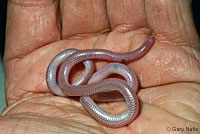 |
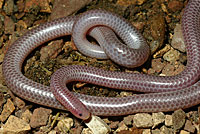 |
Desert Threadsnake
Rena humilis cahuilae |
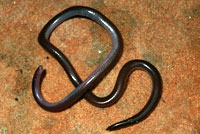 |
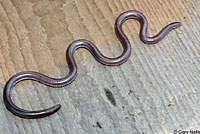 |
Southwestern Threadsnake
Rena humilis humilis |
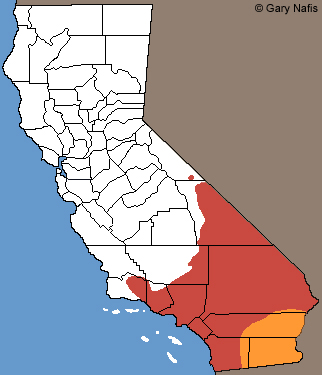
|
Orange: Desert Threadsnake (Blind Snake) - Rena humilis cahuilae
Red: Southwestern Threadsnake (Blind Snake) - Rena humilis humilis
|
| |
|
Brahminy Blindsnake - Indotyphlops (Ramphotyphlops) braminus
This is a non-native blindsnake that has been introduced into Chula Vista in San Diego County and other locations in southern California. It has spread around the world including the Hawaiian Islands and Florida, often in shipments of tropical plants, a fact which gives the species an alternate common name - the Flower Pot Snake.
It can be distinguished from the native threadsnakes by the placement of the dark eye spot, by the appearance of the rostral scale, by counting certain scales and by its shorter tail.
(I don't have any illustration of the tails yet.) More information about identifying the species including some illustrations can be found below.
The Brahminy Blindsnake also tends to be much darker than the native threadsnakes, although some native threadsnakes can also be very dark, so this cannot be used alone to identify the species.
|
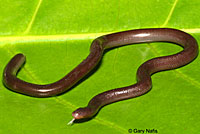 |
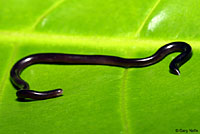 |
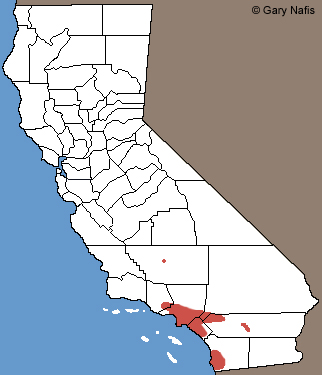
Red: General range of non-native California
populations of Brahminy Blindsnake - Indotyphlops braminus
|
| Keys * to the three types of small worm-like blind snakes found in California |
| |
Desert
Threadsnake
Rena humilis
cahuilae
|
Southwestern Threadsnake
Rena humilis humilis |
Brahminy
Blindsnake
Indotyphlops (Ramphotyphlops) braminus |
| Dorsal Scale Rows |
5 lightly pigmented |
7 or more heavily pigmented |
|
| Dorsal Scales |
285 or more |
usually fewer than 285 |
|
| Scale Rows Around Tail |
12 |
|
|
| Scale Rows at Midbody |
14 |
14 |
18 - 20 |
| Rostral Scale |
Large, pointed on top |
Large, pointed
on top |
Large, inverse U shaped on top, with parallel markings that look like stitches |
| Dark Eye Spot |
Centered in the
ocular scale |
Centered in the
ocular scale |
In the upper portion of the ocular scale. The top of the ocular scale often crosses over the upper edge of the eye spot. |
| Length |
4 - 16 inches
(10 - 41 cm) |
4 - 16 inches
(10 - 41 cm) |
2.5 - 7 inches
(14 - 18 cm.) |
* Based on information in:
Brown, Philip R. A Field Guide to Snakes of California. Gulf Publishing Co., 1997.
Bartlett, R. D. & Patricia P. Bartlett. Guide and Reference to the Snakes of Western North America (North of Mexico) and Hawaii. University Press of Florida, 2009.
Stebbins, Robert C. A Field Guide to Western Reptiles and Amphibians. 3rd Edition. Houghton Mifflin Company, 2003.
Robert Powell, Joseph T. Collins, Errol D. Hooper, Jr. A Key to Amphibians and Reptiles of the Continental United States and Canada. 1998
Dr. Gregory B. Pauly, personal communications.
|

(Click on photo for a more detailed illustration.) |
The Rostral Scale
One way to tell the difference between these two very similar species is to look at the large scale on the front of the nose (the rostral scale.)
The Western Threadsnake, native to California, has a large rostral scale that is pointed up between the eyes in a triangular shape. The edge of the rostral scale is straight
with no markings that look like stitches.
The non-native Brahminy Blindsnake has a large rostral scale that points up between the eyes in an upside down "U" shape. The rostral scale also has edge lines that look like stitches and parallel lines inside the rostral scale that look like rows of stitches. These lines of "stitches" are not present on the Western Threadsnake.
The Dark Eye Spot
Another way to tell the difference between the two species is to look at the the dark eye spot or vestigial eye. On the Western Threadsnake, the dark eye spot is positioned in the center of the ocular scale, the large scale surrounding the eye spot.
The dark eye spot on the Brahminy Blindsnake is in the upper portion of the ocular scale, and the top of the ocular scale often crosses over the upper edge of the eye spot. The ocular scale also appears more pointed on the bottom than on the Western Threadsnake which is wider and flatter on the bottom.
|
  |
Underside of Western Threadsnake Tail
(The tail begins at the vent,
which is the reddish area.)
|
Underside of Brahminy Blindsnake Tail
(The tail begins at the vent,
which is the whitish area.) |
Tail Length
Observing the length of the tail is another way to tell the difference between the two species.
The Brahminy Blindsnake has
a tiny tail that is only 1.5 - 2.5 millimeters long.
The Western Threadsnake (even a very small one) has a much longer tail than the Brahminy Blindsnake
|
If you think you found a Brahminy Blindsnake in California:
Please notify Dr. Gregory B. Pauly at gpauly@nhm.org. Dr. Pauly is Curator of Reptiles and Amphibians at the Natural History Museum of Los Angeles County and is part of a team that is documenting the rapid introduction and establishment of this species into Southern California with the help of people who contact this website and other citizen science projects. If you can, take pictures and send them to him, including close-ups of the eyes and nose if possible. Also, please keep the snake if you can. Someone may want to collect and examine it to confirm that it is a Brahminy Blindsnake and not a native Western Threadsnake which looks a lot like it.
It's not easy to see tiny details on these little snakes, especially when they are squirming around, so if you are still in doubt of the species after checking the identification information, please contact Dr. Pauly anyway. You are welcome to contact me at this web site also if you need to.
|
|
|
Return to the Top
© 2000 -
|













